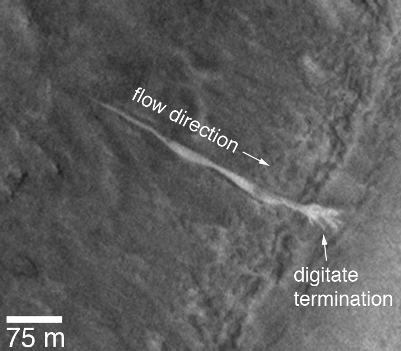 Image: NASA/JPL/Malin Space Science Systems
Image: NASA/JPL/Malin Space Science Systems
Caption: An enlargement of a portion of another image from August 2005, showing details of the new, light-toned gully deposit. The new material covers the entire gully floor, from the point at which the gully emerged from beneath a mantled slope, to the spot at which the channel meets the crater floor. At this break in slope, the gully material, as it was emplaced, spread out into five or six different fingers. Note 75-metre scale bar.
Double impact
It also seems that the swansong of Mars Global Surveyor has two verses. Image comparisons reveal that Mars suffers more high-velocity impacts than scientists suspected. In fact 20 fresh craters, ranging from two to 148 metres across, are known to have formed in the last seven years. Counting craters is the key to determining the relative ages of a planetary surfaces, so this finding could have important implications for calibrating modern impact rates. This in turn holds out the prospect of increasing the method’s resolution, and hence of reaching more accurate age determinations for younger geological features.
So, while NASA will be encouraged by the evidence for water in the Martian subsurface, it is clear that any visitors will have to watch the skies a little more closely than expected.